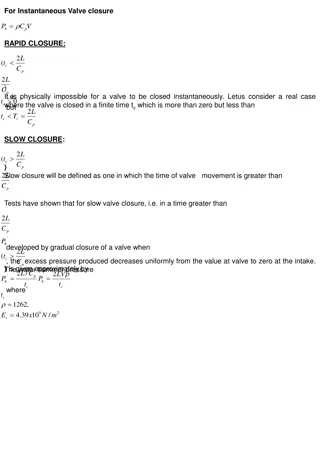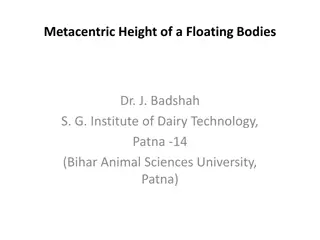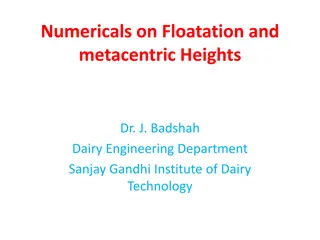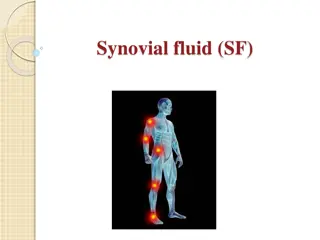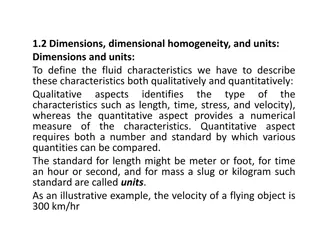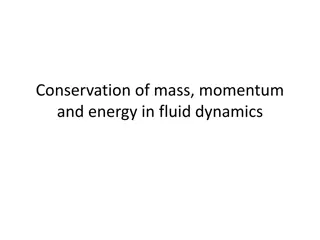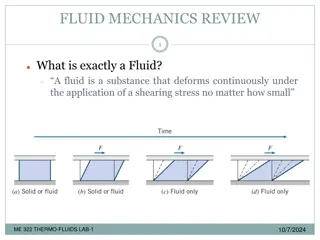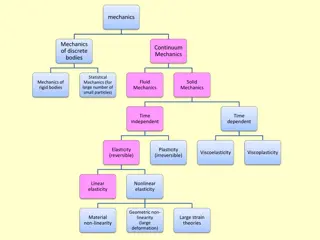Understanding Metacentre and Metacentric Height in Fluid Mechanics
Exploring the concept of metacentre in fluid mechanics, where it is the theoretical point that determines the stability of floating bodies. The metacentric height (GM) is crucial in assessing the initial static stability of a floating object. Learn how the metacentre is defined and its significance in determining a body's stability when displaced or dipped in water. Visual aids and explanations make understanding metacentre and metacentric height easier.
Download Presentation

Please find below an Image/Link to download the presentation.
The content on the website is provided AS IS for your information and personal use only. It may not be sold, licensed, or shared on other websites without obtaining consent from the author. Download presentation by click this link. If you encounter any issues during the download, it is possible that the publisher has removed the file from their server.
E N D
Presentation Transcript
IDHAYA COLLEGE FOR WOMEN KUMBAKONAM 612 001 DEPARTMENT OF PHYSICS : II SEMESTER CLASS : I B.Sc., PHYSICS SUBJECT- INCHARGE : Ms. A. BHARATHI : MECHANICS SUBJECT NAME SUBJECT CODE TOPIC : 16SCCPH2 : METACENTER
METACENTRE Metacentre,in fluid mechanics the theoretical point at which an imaginary vertical line passing through the centre of buoyancy and centre of gravity intersects the imaginary vertical line through a new centre of buoyancy created when the body is displaced or dipped in the water.
Metacentre Whenever a body, floating in a liquid, is given a small angular displacement, it starts oscillating about some point. This point, about which the body starts oscillating is called metacentre. The metacentre may also be defined as the inter section of the line passing through The original centre of buoyancy B and centre of gravity G of the body and the vertical line through the new centre of buoyancy B1,
Metacentre and Metacentric Height Metacentric height (GM):The Distance between the centre of gravity(G) of floating body and the metacentre (M) is called metacentric height.(i.e., distance GM shown in fig) GM=BM-BG
When a ship heels(rolls sideways),the centre of buoyancy of the ship moves laterally. It might also move up or down With respect to the water line. The point at which a vertical line through the heeled centre of buoyancy crosses the line through the original ,vertical centre of buoyancy is the metacentre. The metacentric height is a measurement of the initial static of a floating body. It is calculated as the distance between the center of gravity of a ship and its metacentre.
Metacentre and Metacentric Height Centre of buoyancy(B): The point of application of the force of buoyancy on the body is known as the centre of buoyancy Metacentre(M): The point about which a body in stable equilibrium Start to oscillate when given a small angular displacement is called metacentre.
Determination of metacentric height In figure shown AC is the original waterline lane and B the centre of buoyancy in the equilibrium position When the vessel is tilted through small angle , , the the centre centre of of buoyancy buoyancy will as as a a result result of of the the alteration alteration in in the displaced displaced fluid fluid. . will move move to to B B the shape shape of of A C is the waterline plane in the displaced position.
DETERMINATION OF METACENTRIC HEIGHT (1) 1.PRACTICALLY: W GM =Px GM=Px/W Where: W is the weight of the vessel including P 2.THEORETICALLY MG=BM+OB-OG BM= 1/V OB=0.5 V/bd In water
Types of equilibrium of floating bodies UnstableEquilibrium: if the body does not return back t its original position from the slightly displaced angular displacement and heels farther away, then It is said to be in unstable equilibrium Note: Centre of gravity of the volume (centroid)of fluid displaced is also centre of buoyancy.
METACENTER Relationship between G and M G under M: ship is stable G=M: ship is neutral G over M: ship is unstable
Stability of Floating body A floating body is STABLE if, when it is displaced, it returns to equilibrium. ... For the untilted body the point G is the centre of gravity of the body where the body weight, W, acts. The point B is the centre of buoyancy (the centroid of the displaced volume of fluid) where the upward buoyancy force, FB, acts. a) Stable Equilibrium: If the point M is above G. b) unstable Equilibrium: If the point M is below G. c) Neutral Equilibrium: If the point M is at the G.
Metacentre influence the stability of a floating body: The metacentre remains directly above the centre of buoyancy regardless of the tilt of a floating body, such as a ship. ... If the metacentre is above the centre of gravity, buoyancy restores stability when the ship tilts. How do you find the Metacentre? Metacentre is determined by the ratio between the inertia resistance of the boat and the volume of the boat. (The inertia resistance is a quantified description of how the waterline width of the boat resists overturning.)
NUMERICALS QUESTION: A solid cylinder 2m in diameter and 2m high is floating in water Axis vertical. If the specific gravity of the material of cylinder is 0.65, find Metacentric height .state also whether the equilibrium is stable of unstable. SOLUTION: GIVEN DATA: Size of cylinder=2m diameter and 2m height Specific gravity solid cylinder =0.65 Let h is depth of immersion=? For equilibrium Weight of water displaced=weight of wooden block 9.81(? ?/4(2 /4(2 2)(h)) 2)(h)) 9.81(0.65/4(2 /4(2 2)(2)) 2)(2)) h=0.65(2)=1.3m h=0.65(2)=1.3m
DEFINITION OF BUOYANCY : Buoyancy or upthrust, is an upward force exerted by a fluid that opposes the weight of a partially or fully immersed object. In a column of fluid, pressure increases with depth as a result of the weight of the overlying fluid. Thus the pressure at the bottom of a column of fluid is greater than at the top of the column. Similarly, the pressure at the bottom of an object submerged in a fluid is greater than at the top of the object. The pressure difference results in a net upward force on the object. The magnitude of the force is proportional to the pressure difference, and (as explained by Archimedes' principle) is equivalent to the weight of the fluid that would otherwise occupy the submerged volume of the object, i.e. the displaced fluid.
BUOYANCY AND FLOATATION principle of floatation: The principle of floatation states that when an object floats on a liquid the buoyant force that acts on the object is equal to the weight of the object. ... If the weight of the object is greater than the up thrust, then the object will sink in the fluid. Buoyancy And Floatation. ... Buoyant Force When a body is immersed in a fluid, there is tendency of fluid to exert force on the submerged body. This upward force is same as weight of fluid displaced by the body is known as force of buoyancy or BOYANCY.








